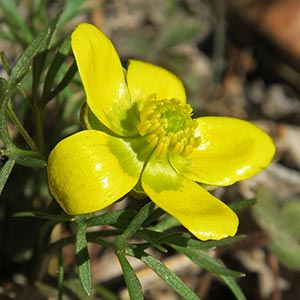Ranunculus orthorhynchus
Ranunculus triternatus
Bloomer's buttercup, straight-beak buttercup, swamp buttercup
Dalles Mountain buttercup, obscure buttercup
sometimes fleshy and ± tuberous.
cylindric, 2-3 mm thick.
nearly erect or decumbent, never rooting nodally, hispid, strigose, or glabrous, base not bulbous.
prostrate or ascending, 5-20 cm, glabrous, each with 1-6 flowers.
blades narrowly ovate to oblong or semicircular in outline, simple to 3-5-lobed or -foliolate, 2.8-12.5 × 2.5-14 cm, leaflets or segments undivided or 1-2x-lobed or -parted, ultimate segments circular to linear, margins dentate, crenate, or entire, apex rounded to narrowly acute.
persistent, blades rhombic to deltate or reniform in outline, 3-4x-dissected, 1.1-3.4 × 2-3.1 cm, segments linear, base obtuse, margins crenate, apices of segments narrowly rounded.
receptacle hispid;
sepals reflexed 1-2 mm above base, 5-11 × 2-4 mm, hispid, hirsute, or glabrous;
petals 5-6, abaxially yellow or red, adaxially yellow, 8-18 × 4-11 mm.
pedicels glabrous;
receptacle short-pubescent;
sepals 4-8 × 2-5 mm, abaxially glabrous or nearly so;
petals 5, 6-15 × 4-10 mm;
nectary scale glabrous.
hemispheric to ovoid, 5-13 × 6-10 mm;
achenes 2.8-4.5 × 1.8-3.2 mm, glabrous, margin forming narrow rib 0.1-0.2 mm wide;
beak persistent, narrowly lanceolate to subulate, straight, 1.8-3.8(-4.8) mm.
depressed-globose, 4-6 × 5-8 mm;
achenes 1.8-2.2 × 1.2-1.8 mm, finely pubescent;
beak subulate, straight, 0.8-1.5 mm.
Ranunculus orthorhynchus
Ranunculus triternatus
Varieties 3
The first two varieties (Ranunculus orthorhynchus var. orthorhynchus and R. orthorhynchus var. platyphyllus) are rather weak, intergrading extensively in California and Oregon. By contrast, R. orthorhynchus var. bloomeri often grows with the others with little or no intergradation (although intermediate populations are found in some areas), and it has been treated as a distinct species, R. bloomeri, by many taxonomists.
(Discussion copyrighted by Flora of North America; reprinted with permission.)
Of conservation concern.
C. L. Hitchcock et al. (1955-1969, vol. 2) considered the name Ranunculus triternatus A. Gray to be an illegitemate homonym and used the illegitimate (superfluous) name R. reconditus A. Nelson & J. F. Macbride for this species. The name Ranunculus triternatus Poiret was not validly published (not accepted by Poiret) and does not invalidate R. triternatus A. Gray.
(Discussion copyrighted by Flora of North America; reprinted with permission.)
1. Basal leaves simple or 3-foliolate, if compound then leaflets undivided, margins crenate; petals retuse. | var. bloomeri |
1. Basal leaves 3–5-foliolate, leaflets lobed or parted, margins entire or dentate; petals truncate or rounded. | → 2 |
2. Heads of achenes hemispheric or sometimes globose, 5–7 mm; petals often abaxially red. | var. orthorhynchus |
2. Heads of achenes globose or ovoid, 8–13 mm; petals yellow. | var. platyphyllus |
- Local floras:
BC,
CA,
OR,
WA
- Local Web sites:
CalFlora,
CalPhotos,
Flora NW,
PNW Herbaria,
Turner Photog.
WildflowerSearch
iNaturalist (observations)
USDA Plants Database
- LBJ Wildflower Center
- SEINet
- Plants of the World Online
- Encyclopedia of Life
- Wikipedia
- Google Image Search


